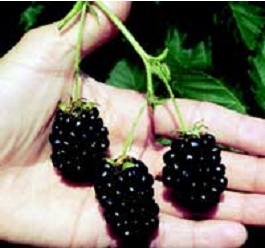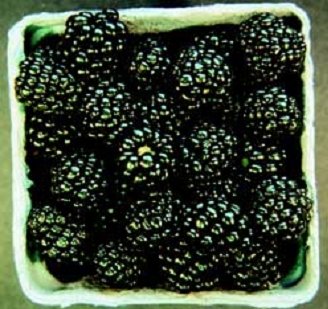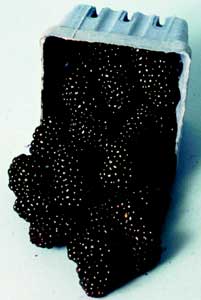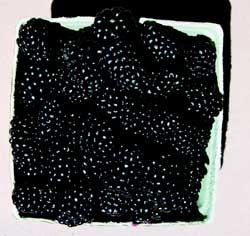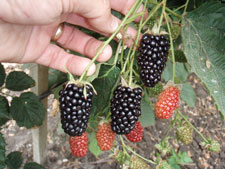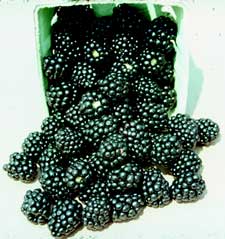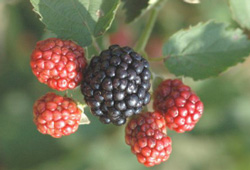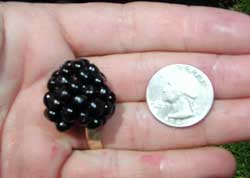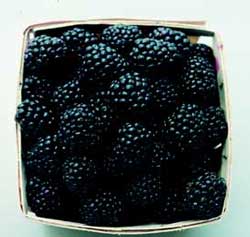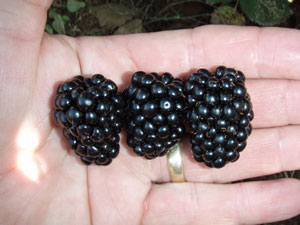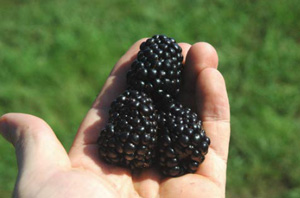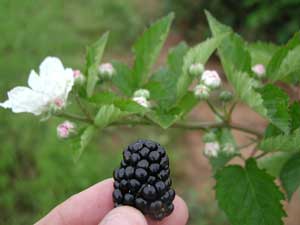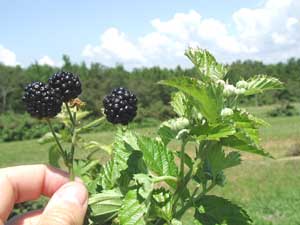Contact
Amanda McWhirt
Extension Fruit & Nut Specialist
Phone: 501-671-2229
Fax: 501-671-2252
Email: amcwhirt@uada.edu
UAEX
2301 South University Ave
Little Rock, AR 72204
Blackberries and Raspberries in Arkansas
Blackberries are a native crop to many areas of the United States and are adapted to a wide range of environments. Unlike many fruit crops, blackberries can be grown with little to no pesticide use in the home garden and require fewer inputs in commercial production.
What soil works best?
Wide adaptation to soil type is found with blackberries. The preferred soil pH is 5.5 to 6.5. Good drainage is required. Plants should not be grown in sites where water stands for long periods.
What limits blackberry production?
The most limiting factor in blackberry production in the northern United States is winter hardiness, or resistance to winter injury to the canes.
The Arkansas varieties lack hardiness in the upper Midwest and northward. The major limitation to blackberry production in the Deep South is the fungal disease double blossom/rosette, to which the Arkansas-developed thornless varieties show resistance.
What varieties are adapted to our state?
The Arkansas varieties have been shown to be adapted statewide. They are upright in growth habit and should be grown in a hedgerow-type system. They do not require the trellising system used for trailing and semi-erect varieties.
How are blackberries grown?
Blackberries are established from plants or root cuttings spaced 2 to 3 feet apart. The first crop is harvested the year after planting.
University of Arkansas patented blackberry cultivars are available from licensed fruit propagators.
Resources
- Blackberry Production in the Home Garden
- Management of Important Blackberry Diseases in Arkansas (color)
- Raspberry Crown Borer
- Home Garden Blackberry Production website
- Arkansas Blackberry School (Free Online Webinar Series)
- RCA Trellis for Blackberry Production
- 2023 Small Fruit Management Schedule
- "What is wrong with my blackberry?" Factsheet
- Blackberry Plant Tissue Nutrient Sampling
- Calculating Blackberry Fertility Rates
- Managing Diseases in Blackberry – Building a Fungicide Spray Schedule
Pruning Tutorials:
- Winter Pruning of Floricane-Fruiting Blackberries
- Early Summer Pruning of Floricane-Fruiting Blackberries
- Winter Pruning of Primocane-Fruiting Blackberries
- Summer Tipping: How to Prune Primocane-Fruiting Blackberries
University of Arkansas Floricane-Fruiting Cultivars
* expired patent
University of Arkansas Primocane-Fruiting Cultivars
What is a primocane-fruiting blackberry? This is a type of blackberry that fruits on current-season canes (primocanes). All previous blackberry varieties are floricane-fruiting, thus the canes must be overwintered for fruiting the second year. This new type of blackberry could greatly change blackberry production.
Primocane-fruiting blackberries hold great promise for several reasons. First, they have the potential to produce more than one “crop” per year, having the potential for the normal summer crop (the floricane crop) and a later crop on the current season primocanes. In fact, these new varieties have been observed to flower and fruit until frost, depending on late summer and fall temperatures, plant health, and location. In more northern climates, they have the potential to provide a crop even if floricanes are damaged by winter cold since the primocanes grow and fruit in the same season. In this instance, pruning is done simply by mowing the canes down in the winter.
The first commercial primocane-fruiting blackberry cultivars were released by the University of Arkansas in 2004. These are the first in what should be a number of advances in this exciting type of blackberry.
The first two cultivars released in the Prime-Ark™ Floricane-Fruiting blackberry series were Prime-Jim® and Prime-Jan®. In 2009 Prime-Ark® 45 was released.
Older University of Arkansas Cultivars Released Prior to 1980 and Not Patented
| Characteristics | 'Cherokee' | 'Comanche' | 'Cheyenne' |
|---|---|---|---|
| Type | Thorny, erect | Thorny, erect | Thorny, erect |
| Date of Release | 1974 | 1974 | 1976 |
| Fruit Size | 5 grams | 6 grams | |
| Yield | Medium | Medium | Medium |
| Maturity Date | June 14 | June 5 | June 10 |
| Flavor/Sweetness (Soluble Solids) |
Very Good 9.7 percent SS |
Good 9.8 percent SS |
Good 9.7 percent SS |
